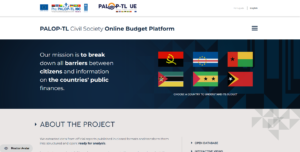Civil Society Organisations and Ministries of Finances from the PALOP-TL countries (Angola, Cabo Verde, Guinea Bissau, Mozambique, São Tomé e Príncipe, Timor-Leste) developed the 1st ever transnational digital network for citizens’ fiscal literacy and participation in budget cycles. The Digital Platform uses data transparency tools with pictographic representation to simplify complex budgetary documents for the wider public, increasing transparency and accountability in public finance management.
Innovation Summary
Innovation Overview
Most evaluations on decision-making regarding the public accounts and budgets identify public participation as the weakest among all (executive, supreme audit institutions and parliament) the parts involved in Public Finance Management – see International Budget Partnership Reports. The multi-country PALOP-TL eBudget CSO Digital Platform for transparency & accountability is the 1st ever transnational digital network for citizens’ fiscal literacy and participation in budget cycles on a “regional scale”, covering the PALOP-TL countries (Angola, Cabo Verde, Guinea Bissau, Mozambique, São Tomé and Príncipe, and Timor-Leste). Between April 2020 and September 2021, in the context of the EU-funded UNDP multi-country south-south and triangular cooperation programme for consolidating Economic Governance and Public Finance Management Systems in the PALOP-TL countries (Pro PALOP-TL SAI), a team of economists, IT developers and public finance experts used design thinking to develop a pilot digital platform using data transparency tools with pictographic representation to simplify complex budgetary information, often presented in closed formats, and making it simple, accessible and open to the wider public.
To navigate this unique platform more friendly and interactively, a 3D based avatar will guide (design phase ongoing) users in an interactive tutorial tour. The avatar will represent instructions with natural behaviours (e.g., eye blinking, lip sync and natural body movements) using a technology based on game engines and 3D web-based rendering technologies (e.g., webGL). The platform makes available disaggregated fiscal data (Enacted budgets, in-Year and Year-End Expenditure reports) since 2016 up to date to interested citizens and institutions, namely: researchers and academics in universities and other academic institutions, independent public finance experts and practitioners, parliamentarians and parliamentary staffers, auditors in Supreme Audit Institutions, staffers in Ministries of Finances, staffers in Development Agencies and International Financial Institutions, among others. The platform additionally ranks the countries covered according to 3 budget transparency criteria aligned with best practices: open data, frequency/regularity of expenditure reporting, level of detail in fiscal information disclosed by these reports.
The platform was inspired in the Nigerian BudgIT and the Brazilian Mosaiko Orçamentário – both are from Federal States (similarity with its multi-country/regional scope). It uses some of the same principles but scales them up to a multi-country level and finds a solution for standardization between different states. Ideation and design of the pilot took around 17 months with the expert team accessing the availability of fiscal data in all 6 countries, determining the potential and parameters to present it in a standardized and comparable way. They were carried out in two working fronts simultaneously: public finance (content and presentation of data to the public) and IT development (architecture and backend of the platform to the users/owners). From October 2021 to April 2022, the final phase for testing and training users/owners (both on content management and IT support) was rolled-out in all 6 countries with 72 people involved (members of civil society organizations and staff from ministries of finance), of which:
- 43 are able to understand how the platform works and its founding principles.
- 14 are proficient in “hacking” budgetary data from closed formats (PDFs), reorganize, process and upload this data according to the platform parameters, as well as to produce the PALOP-TL yearly budget transparency index.
Additionally, a pool of 29 IT developers are now familiarized with the platform IT architecture. 18 of which are accredited to operate the entire IT structure. A 3-month Lab and inception phase will soon start involving only the users with credentials to operate and manage content aiming to enhance national/local ownership and sustainability. The Platform enables to increase, in quantity and in quality, the participation of civil society in decision-making related to public accounts and budgets. It also enhances fiscal transparency by the executive by measuring its ability to disclose fiscal information to the public in open format (open data), regularly and with sufficient detail allowing to “follow the money”. A governance transnational network is chaired by civil society organisations in the 6 countries. The network also includes focal points from ministries of finances and observers from development agencies and international financial institutions. Ad-Hoc panels for peer reviews are also an important managing tool to ensure quality control and credibility of all products related with the platform. Considering its multi-country scope, the platform showcases how the scale-up to a regional level could be envisioned.
Innovation Description
What Makes Your Project Innovative?
The multi-country PALOP-TL eBudget CSO Digital Platform for transparency & accountability is the 1st ever transnational digital network for citizens’ fiscal literacy and participation in budget cycles on a “regional scale”, covering the PALOP-TL countries (Angola, Cabo Verde, Guinea Bissau, Mozambique, São Tomé and Príncipe, and Timor-Leste). The platform was inspired in the Nigerian BudgIT and the Brazilian Mosaiko Orçamentário – both are from Federal States (similarity with its multi-country/regional scope). It uses some of the same principles but scales them up to a multi-country level and finds a solution for standardization between different states. The platform makes available in a friendly, informative and interactive manner disaggregated fiscal data in yearly series since 2016. The platform ranks the countries according to 3 criteria aligned with best practices: open data, frequency/regularity of expenditure reporting, detail in fiscal information disclosed by these reports.
What is the current status of your innovation?
From October 2021 to April 2022, the final phase for testing and training users/owners (both on content management and IT support) was rolled-out in all 6 countries with 72 people involved (members of civil society organizations and staff from ministries of finance). It involved mapping relevant fiscal information, evaluating the consistency of official information accessed, structuring databases, design and communication, as well as the development of the only existing budget transparency able to compare the countries covered by the platform in yearly series. The IT development involved structuring the digital platform format using Python with Django framework to put in place the requirements for data to be uploaded with security. The Digital eBudget CSO PALOP-TL platform is being institutionalized through a 3-month inception phase ending in the first quarter of 2023.
Innovation Development
Collaborations & Partnerships
The platform was developed by staff members and experts recruited by UNDP in the framework of the Pro PALOP-TL SAI programme. Throughout its development and testing phases, civil society organisations and ministry of finances partnered with UNDP, to ensure accuracy of the information and the effective needs respectively. The IT developers were trained to ensure operability. They came from startups and IT units in ministries of finances. The Avatar is being developed by a company.
Users, Stakeholders & Beneficiaries
- Citizens
- Government officials
- Civil society organisations
- Universities and other academic institutions
- Parliaments, particularly parliamentary budget offices and legislative budget committees (MPs and staffers)
- Media
All can access information on public expenditures in one place, presented in a simple manner, allowing comparation among sectors and among countries. All can get an idea of the measure of each country's budget transparency.
Innovation Reflections
Results, Outcomes & Impacts
Main results/outputs:
- Fiscal information, accessible in open source in one location, presented in a friendly and interactive manner, updated in a yearly basis since 2016.
- The only budget transparency index using budget transparency and open data standards to compare these 6 countries for budgetary data presented in open data format, regularly and frequently, with enough details allowing to “follow the money”.
- More than 70 people are familiar with the platform and advocate for budget transparency and participation of the public in budget processes. More than 30 persons are accredited to operate it sustainably.
Outcomes:
- Ministries of Finances promote more access to fiscal information in open data format, more regularly and with greater detail.
- Ministries of Finances and CSOs work closer together to promote independent access to fiscal information.
- Ministries of Finances use the platform as one of their main sources to disclose fiscal information in a credible manner.
Challenges and Failures
The main challenges encountered were related with:
- Weak and dissimilar capacities among members of the civil society in data manipulation methods and public finance management in general.
- Low commitment in some trainees impacting the learning pace and experience.
- Capacity to work and foster dynamics among the 6 countries independently.
- These challenges let to the rollout of an additional phase for inception of the accredited trainees and to enhance ownership.
Conditions for Success
In order for the platform to be successful, there needs to be enough training time for the teams operating it, as well as enough financial resources to ensure that a number of other initiatives (e.g., advocacy, seminars, training) be implemented using it as tool. It is also paramount that a strong leadership of CSO members ensures the governance and management of the platform, as well as good relations with the ministries of finances. Last, but not least, there must be a pool of proficient developers ensuring the backend support and security of the platform. It is important that the platform is developed in groups of countries with comparable structures for Public Budgets and expenditure reports.
Replication
The platform was inspired in the Nigerian BudgIT and the Brazilian Mosaiko Orçamentário – both are from Federal States (similarity with its multi-country/regional scope). It uses some of the same principles but scales them up to a multi-country level and finds a solution for standardization between different states. In this context, the platform could be scaled up at sub-regional or regional levels in sub-Saharan Africa, by clustering countries according to similar budget and public accounting systems.
Lessons Learned
- There is much space to explore synergies between the executive and CSOs in the field of budget transparency for the participation of the public in budgetary processes.
- The use of a long project lifecycle and design thinking was fundamental to ensure buy-in from all stakeholders.
- The involvement of the ministry of finances in an early stage is very important for the success of the platform in accessing fiscal data.
- Once the data is uploaded and is credible, all stakeholders are interested in maintaining it updated.
- Financial resources are needed to ensure the hosting of the platform in a secured server.
Anything Else?
The multi-country PALOP-TL eBudget CSO Digital Platform for transparency & accountability was developed to be modular. During the training phase, there was a demand for the inclusion of two other classifications of expenditure: programmatic (which follows government programs and actions) and by nature (Investments; Interest and debt burden; Financial Investments; Amortization; Other expenses chains). In addition, beneficiaries suggested monitoring other variables such as the transfer of resources from the central government to smaller government units and public debt.
Project Pitch
Supporting Videos
Status:
- Implementation - making the innovation happen
Date Published:
19 July 2023


